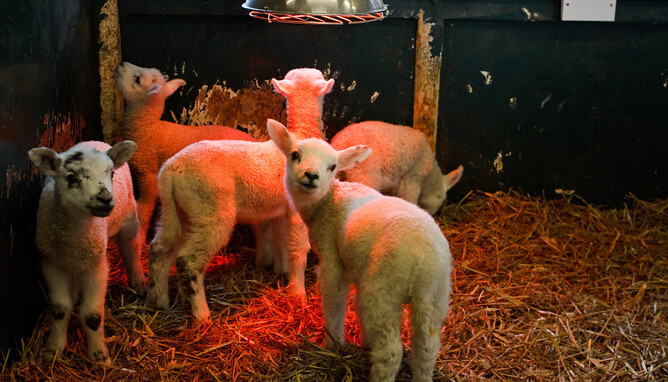Here is a summary of conditions we recommend for best health outcomes for rearing orphan lambs.
From day 1, the essential conditions and requirements are:
- Warm, dry, draft free and clean space!
- Fresh straw/hay and meal/muesli feed should be available from day 1.
- Tube 3 x 250ml colostrum feeds within the first 24 hours.
- If lamb is weak/comatose: inject dextrose into abdomen (this must be done before warming the lamb up), tube colostrum into the stomach and place in a warmer or under heat lamps.
- Spray every naval with iodine and treat swollen ones with 1ml penicillin, injected daily for 5 days (if they get an infection later or joints are infected treat with 2-3ml every 48 hours).
- Scratch every lamb ONLY IF scabby mouth is present on farm.
- Lambs need 10-15% or their body weight of milk daily.
- Milk should be 35-40 degrees (which feels very warm).
- Should be fed at least three times a day until around 2 weeks old, then can be reduced to two times a day and once a day from 3 weeks old.
- They will initially need to be individually fed with a bottle before being transitioned onto a feeder from around 2 days old. This should still be monitored to ensure all lambs are fed equally.
- Keep the pens as clean and bug free as possible by spraying weekly with disinfectant.
- When consuming 100 grams of meal a day can go out to grass - this is usually around three weeks of age.
- When consuming 200 grams of meal a day (or when 10-12kg or 4-5 weeks old) can be weaned.
- When consuming 400-700 grams of meal a day (or when 20kg or 8-10 weeks old) can move to only consuming high quality pasture (not less than 1600 kg DM/ha).
Bloat is the biggest cause of death in reared lambs:It usually occurs from 3-4 weeks old and it occurs 1-2 hours after drinking a sudden gorge.
- Treat with 3ml penicillin orally ASAP or inject directly into the gut.
- If about to die, hold the lamb on it’s back and insert a 16G 1 inch needle straight into the stomach by placing it on the midline in between the end of the sternum and the navel. Then give 1ml penicillin/10 kg into the muscle.
- To prevent: keep lambs on twice daily feeding until weaning, add 10-15 grams of baking soda or yoghurtised milk. Alternatively the use of whey based milk replacers have also been shown to reduce the incidence of bloat.
Tips:
- Watch the lambs when using the feeder early on and re-group into slow and fast drinkers.
- Using a soft teat initially and moving onto a hard teat will help lambs learn to suckle.
- If ad lib feeding there should be at least 1 teat per 5 lambs, milk should be fed cold (to restrict intake) and the feeder shouldn’t be empty for more than two hours.
- If needing to feed cows milk, it has lower energy and fat but higher lactose. Therefore it should be altered by: adding lamb milk replacer at 75 gram/litre or yoghurtising the milk.
- If scouring, try feeding an electrolyte solution in between milk feeds (ensuring fresh water is available too).
- Assume orphan lambs have no maternal protection against Clostridia, they should therefore be given three doses of 5 in 1 with an additional first dose earlier than other lambs.

